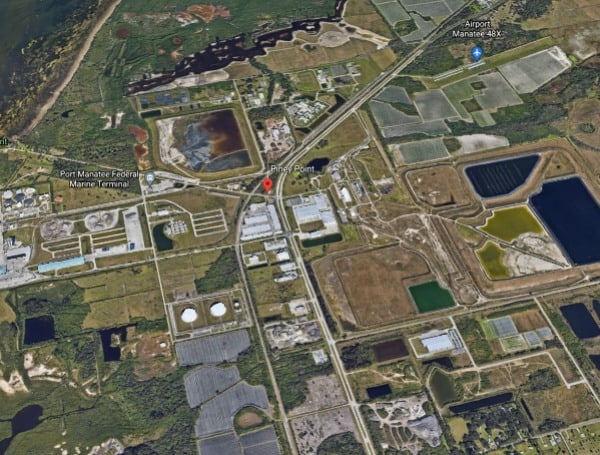In an ongoing investigation into the Piney Point debacle, The Free Press continues its search for the truth regarding who is responsible for the near 30-year disaster at Piney Point and why something wasn’t done long ago?
As reported April 8, documents obtained by TFP provide ample evidence that not only was the Florida Department of Environmental Protection (FDEP) made aware of numerous concerns about the stability of the stack system and issued warnings about pending disasters, FDEP ordered HRK to continue running operations as usual until they said otherwise.
In a March 13, 2020 letter to John Coates — FDEP’s project manager of the Piney Point site — Michael Kelley, the principal engineer of Wood Environment & Infrastructure Solutions, Inc. – wrote to express “concerns about the current condition of the New Gyp Stack South” and recommended that “NGS-S be removed from the process wastewater management system as the designated Emergency Diversion Impoundment.”
“During a site meeting on September 25, 2019, with HRK, Wood, and FDEP representatives,” Kelley reminded Coates, “it was agreed that no additional wastewater will be placed into the NGS-S until liner repairs and further evaluation of the pond integrity could be completed.”
In a letter of response, dated May 15, 2020, Coates systematically dismissed Kelley’s concerns and warnings and instead, repeatedly questioned Kelley about “what objective information Wood may have been aware of, and relied upon, in the formation of these statements, and when was this information obtained.”
“We respect and appreciate Wood’s established professionalism and expertise,” Coates seemed to patronize, “and the clarification was useful to understand Wood’s motivation for why the letter was sent directly to the Department, despite your engagement as the third-party engineer for HRK.”
Now, in documents obtained by TFP, FDEP is apparently admitting there are serious problems with the stack system as reported by Wood and HRK all along.
In an Emergency Final Order, issued March 19, 2021, FDEP Deputy Secretary, Regulatory Programs John J. Truitt acknowledges the existence of the same problems dismissed by Coates.
“On March 25, 2021,” the order states “HRK reported increased flow and specific conductance (conductivity) measurements in the buried seepage interceptor drains that surround the System and flow to the Structure No. 1 pump station (Structure 1) at the Site. Based on HRK’s information and a Department site visit conducted on the evening of March 25, 2021, it appears that increased flows and conductivity measurements may indicate the presence of a leak from the Site’s NGS-S lined compartment.”
“As of March 28, 2021,” the order states further, “the drain flow rates and conductivity measurements at Structure 1 have remained elevated and the source of these changed conditions has not been identified.”
“Given the uncertainty in the source of the increased drain flow rates and increased conductivity measurements at Structure 1, there are potential risks associated with each of the lined compartments currently storing process water or a mixture of seawater and process water, specifically including the process water in the NGS-N compartment and the Mixed Seawater in the NGS-S compartment. At the present time, the observations noted above are suspected to be from the Mixed Seawater in the NGS-S that appears to be at risk of pressurizing the buried drain system at the Site, and potentially causing System instability including uncontrolled boils in the lined stormwater ditches, south or west of the OGS-S or south and east of the NGS-S, or failure of the gypsum dikes or the earthen dikes that may result in an uncontrolled failure and discharge offsite, particularly along the exterior walls of OGS-S and NGS-S compartments.”
“If HRK determines, based on recommendation of a third party registered professional engineer, that (1) the immediate emergency actions -described in Paragraph 18 above, along with other emergency actions to prevent destabilization of containment structures within the System, are not adequate to contain Mixed Seawater within the NGS-S or process water in the NGS-N without a risk of a catastrophic release and (2) there is no feasible alternative, then HRK is hereby approved to first begin temporarily discharging the Mixed Seawater through the NGS-S decant structure to Class-III marine waters of the state at Port Manatee as a bypass pursuant to NPDES Permit No. FL0000124003-AA-.”
“Until such time as the water can be removed from the site,” Coates concluded in his dismissive May 15 letter, “HRK must continue to take steps to safely store process water and maintain compliance with the environmental protections in Chapter 62-672, Fla. Admin. Code.”
“Considering the fact that the concerns expressed to you by Woods a year ago were now clearly valid and the threat of a system failure looms as Wood predicted,” TFP asked Coates by email April 7, “can you please provide a statement regarding your decision to dismiss the concerns posed by Woods and their warnings that these matters would result in the current conditions at Piney Point?”
After contacting Coates a second time, his one-sentence response simply stated that the inquiry had been forwarded to their press office. A full week later, Florida Department of Environmental Protection Press Secretary Weesam Khoury replied to provide an official explanation as to why Coates had been so dismissive with Kelley’s concerns and warnings.
“Attached you will find the department’s reply to the correspondence you are referencing which was sent in May,” Koury informed TFP in an email dated April 15. “We did not receive a response. In June, we then received the annual inspection report that was submitted by this same firm. The firm’s conclusions, as noted in this certified report’s summary are as follows, ‘The Phosphogypsum Stack System at HRK’s Piney Point facility is generally in good condition based on Wood’s visual inspection. The ponds continue to be operated within design limits or engineer certified temporary operating levels.’”
The attached “department’s reply to the correspondence” was the same May 15, 2020 letter referenced by TFP in the April 8 story and in TFP’s email to Coates requesting a statement regarding the dismissive nature of that letter.
The attached “annual inspection report” — 2019 ANNUAL INSPECTION REPORT PHOSPHOGYPSUM STACK SYSTEM PINEY POINT FACILITY – was written by Kelley on behalf of HRK Holdings LLC and is dated June 2020.
What Khoury failed to address was the March 13, 2020 letter from Kelley to Coates, which preceded the June 2020 report by one month.
In addition, Khoury failed to site Kelley’s list of “critical conditions” that existed at Piney Point written directly below the paragraph he selectively quoted regarding Kelley’s assessment that the system “is generally in good condition.”
“During 2019, HRK conducted liner inspections and identified liner damage above the pondwater line throughout the NGS pond system,” Kelley noted in the June 2020 report. “The liner damage was reported to FDEP as critical conditions in accordance with FAC 62.672.770. Liner repairs were completed by Chesapeake Containment System on multiple occasions with quality assurance inspection provided by Wood.”
“The ponds should continue to be inspected for continued degradation and liner damage throughout 2020.”
“The NGS-S liner system has shown significant degradation over the previous years and requires vigilant regular inspection and repairs to provide adequate containment of process wastewater,” Kelley stated in the June 2020 report. The water level within the NGS-S should be maintained at a level substantially below the maximum design pool elevation until evaluations of the liner integrity and modifications to the water management plan can be implemented.”
The questions that still remain unanswered are:
Why would Khoury expect a response to the May 15, 2020, dismissive reply from Coates to a letter of concern and warning written by Kelley two months earlier on March 13, 2020?
What bearing does the June 2020 report by Wood, based on inspections conducted in 2019, have on Kelley’s letter of concern dated March 13, 2020 or the subsequent dismissive May 15 reply written by Coates?
Why did Coates dismiss the concerns and warnings expressed by Kelley in the March 13 letter? Considering the acknowledgment that there are serious problems with the stack system at Piney Point by FDEP Deputy Secretary, Regulatory Programs John J. Truitt in his Emergency Final Order, issued March 19, 2021, why did FDEP Press Secretary Weesam Khoury use the June 2020 annual inspection report based on a 2019 inspection to justify the dismissive May 15 letter from Coates.
We will be staying with this story and getting answers to these questions.


